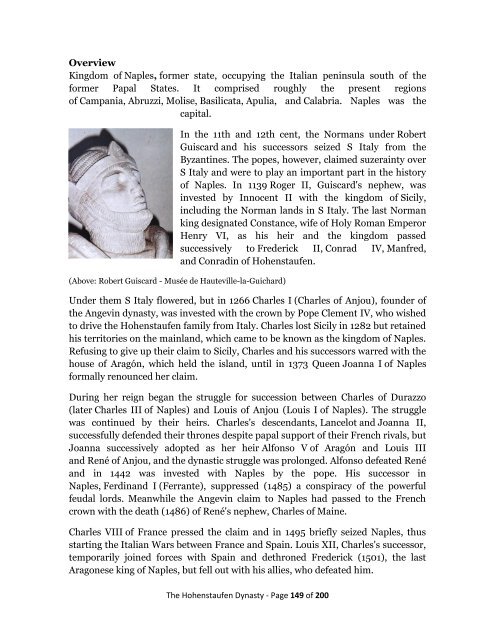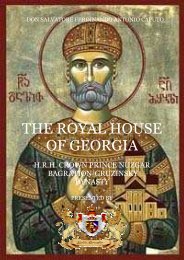here - Nobility Associations
here - Nobility Associations
here - Nobility Associations
You also want an ePaper? Increase the reach of your titles
YUMPU automatically turns print PDFs into web optimized ePapers that Google loves.
Overview<br />
Kingdom of Naples, former state, occupying the Italian peninsula south of the<br />
former Papal States. It comprised roughly the present regions<br />
of Campania, Abruzzi, Molise, Basilicata, Apulia, and Calabria. Naples was the<br />
capital.<br />
(Above: Robert Guiscard - Musée de Hauteville-la-Guichard)<br />
In the 11th and 12th cent, the Normans under Robert<br />
Guiscard and his successors seized S Italy from the<br />
Byzantines. The popes, however, claimed suzerainty over<br />
S Italy and were to play an important part in the history<br />
of Naples. In 1139 Roger II, Guiscard's nephew, was<br />
invested by Innocent II with the kingdom of Sicily,<br />
including the Norman lands in S Italy. The last Norman<br />
king designated Constance, wife of Holy Roman Emperor<br />
Henry VI, as his heir and the kingdom passed<br />
successively to Frederick II, Conrad IV, Manfred,<br />
and Conradin of Hohenstaufen.<br />
Under them S Italy flowered, but in 1266 Charles I (Charles of Anjou), founder of<br />
the Angevin dynasty, was invested with the crown by Pope Clement IV, who wished<br />
to drive the Hohenstaufen family from Italy. Charles lost Sicily in 1282 but retained<br />
his territories on the mainland, which came to be known as the kingdom of Naples.<br />
Refusing to give up their claim to Sicily, Charles and his successors warred with the<br />
house of Aragón, which held the island, until in 1373 Queen Joanna I of Naples<br />
formally renounced her claim.<br />
During her reign began the struggle for succession between Charles of Durazzo<br />
(later Charles III of Naples) and Louis of Anjou (Louis I of Naples). The struggle<br />
was continued by their heirs. Charles's descendants, Lancelot and Joanna II,<br />
successfully defended their thrones despite papal support of their French rivals, but<br />
Joanna successively adopted as her heir Alfonso V of Aragón and Louis III<br />
and René of Anjou, and the dynastic struggle was prolonged. Alfonso defeated René<br />
and in 1442 was invested with Naples by the pope. His successor in<br />
Naples, Ferdinand I (Ferrante), suppressed (1485) a conspiracy of the powerful<br />
feudal lords. Meanwhile the Angevin claim to Naples had passed to the French<br />
crown with the death (1486) of René's nephew, Charles of Maine.<br />
Charles VIII of France pressed the claim and in 1495 briefly seized Naples, thus<br />
starting the Italian Wars between France and Spain. Louis XII, Charles's successor,<br />
temporarily joined forces with Spain and dethroned Frederick (1501), the last<br />
Aragonese king of Naples, but fell out with his allies, who defeated him.<br />
The Hohenstaufen Dynasty - Page 149 of 200



